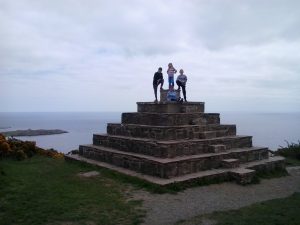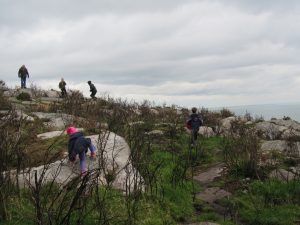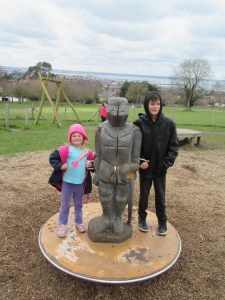Once we’d moved into our house and done a bit of unpacking and recovered from all the above the next item on the agenda was to explore our new surroundings. My agenda, anyway, and that’s the one that counts. The kids would have been happy to stay home and watch t.v. but this is not a democracy, people. I kept making them put their woollies on and get out into the world and live.
We live in the suburb of Killiney (Kil-LINE-ee) near the port of Dun Laoghaire (Dun Leary) on the south side of Dublin. Like this:
You can see how much sea we can see, so to speak, from just about anywhere around here. It’s nice having so much water around. You don’t feel as though you’re in the middle of a big soulless city. And people really use all this water. People go boating and scuba diving and fishing and swimming and all sorts. There’s a scuba school and a sailing school in the local town, Dun Laoghaire, so whenever I’m waiting for the bus I have fun watching all the wet people traipsing past in their life jackets carrying paddles on their way from the harbour to wherever it is that they go to dry off and defrost. This happens year round. I don’t feel the need to participate, although Daniel did some kayaking and wharf-jumping last term with his class.
The first place we explored was Killiney Hill. From our house it’s a walk of 10 or 15 minutes to the start of the park, marked by a statue of Daedalus of not-listening-to-his-father fame. A great teaching moment every single time we pass it.
You walk up a gentle slope and come upon some not-too-shabby views of Killiney Beach and Bray Head to the south:
Oh, did you think I was joking about Enya’s castle? No. She lives in a legit castle and we walk past it when we’re going to the beach. We pass under this arch and there it is:
I really, really love that I have to walk under a castle archway to get to the beach. I have a medieval moment.
Bono lives next door (to Enya, not to us. I like to think of him popping over the fence every now and then for a cuppa and a bit of a jam session) and apparently is seen occasionally in our local pub, The Druid’s Chair. I haven’t bumped into him yet but I’ll keep you posted.
Anyhoo. Back to Killiney Hill. The first time we went there the view of the Wicklow hills to the south looked like this:
which had Noah and Cassia clamouring to go skiing. Another time, maybe.
So you tear yourself away from the views, which are said to include Wales on a clear day (I couldn’t understand why Cassia was so disappointed about not seeing it the first couple of times until she said ‘Well what about dolphins then? Can we see dolphins instead?’) and come across some rocks – there’s a path, but why would you? – which take you to the obelisk.
It was built in 1742 as a relief project to help people suffering from the 1741-42 famine, caused by weather so severe that small boats on the River Liffey were crushed by ice. The land was owned at the time by a wealthy guy called John Mapas who commissioned the obelisk and walking paths to provide employment. The park as a whole was made public and dedicated to Queen Victoria by Prince Albert to commemorate her 50th jubilee in 1887 and was re-named Victoria Hill.
From the summit you can see all over Dublin and the bay, and can climb on a variety of follies and monuments. Here is Dalkey Island, which has quite a lot of history for such a small place.
Next you clamber over more stones because following the path is too easy
Until you come to the quarry. Killiney Hill used to be bigger but they used some of it to make Dun Laoghaire harbour.
If you look very carefully you can see people rock climbing. Daniel’s class came here and did this last term. How cool is it that we can live in this big city and he can still do authentic outdoors rock climbing within walking distance of school?
You go down through the quarry and some forest and come out at this lovely wooden playground:

Once you’ve exhausted yourself watching the kids zoom around you wander along a path through more trees and past another castle
Once more past Daedalus (‘Don’t you think he wished he’d listened to his parents? I bet he really really wished he had’)
And then you go home and think how great it is that you live right next to a place with all these running-around and climbing opportunities.
The next outing was to the local town of Dun Laoghaire. We’d had to give the rental car back by then so we took the bus from outside our house. It hadn’t occurred to me until we got on that none of the kids had been on a double-decker bus before and I tell you, the excitement was extreme.
Luckily it’s a fairly sparsely used route, especially on a weekday during term time, because they all went up the front on the top deck and quickly discovered that if you jump at the right moment as the bus goes over a speed bump you can defy gravity. There are many speed bumps on our bus route.
There was only one other passenger on the top deck, an elderly lady sitting a few rows behind us, and eventually I felt the need to apologise to her for the noise. It wasn’t a problem, she assured me; she’d recently been on a double-decker train for the first time and had the same reaction. Not quite the same, I’d be willing to bet – I didn’t peg her as the jumping up and down screeching with excitement type – but she was very kind about it anyway. Cheap thrills, I thought, mentally bookmarking bus-riding as a handy wet-weekend activity.
Dun Laoghaire is a town of two parts, I’ve decided. The main street and shopping area are old and tired with quite a few empty shops and things falling apart. The sea front, though, is beautiful. That’s where the council’s been investing their development money I’d say.
There’s the harbour with two piers you can walk along – one even has an ice cream kiosk at the sea end – and all the little sailing boats and big ships to watch. There are plenty of walkways and cycleways along the waterfront that connect the harbour with the local beaches, and plenty of green areas around them. There are cafés and restaurants and the lovely new library complex with its glass sea-frontage. There’s a theatre, sculptures, several huge old churches, the Maritime Museum and lots of benches and tables with umbrellas and places to sit and enjoy the view. There are flowers all over the place and two playgrounds, one on the waterfront:
and one in the People’s Park:
Seeing it was such a nice day the kids explored along the water’s edge
while I amused myself by saying ‘Be careful! Don’t fall in!’ over and over, which is what we mothers like to do on these occasions.
Our next stop was Bray Beach. Killiney Beach is closer, just a short walk past Enya’s and Bono’s places and down Vico Road, but it was winter when we arrived and Killiney Beach only has the beach whereas Bray has the aquarium and playground and various other things to do in the cold and places to warm up afterwards.
We liked the aquarium. It wasn’t new or flash or full of interactive technology but it had lots of sea creatures looked after by people with an obvious passion for conservation. We watched the octopus being fed and the kids loved the stories the keeper told of the mischief of various types that these incredibly intelligent creatures have been known to get up to. They are sneaky.
We liked the beach too. Like most around here it’s long and wide and very beachy.
As always, we had to carry fifteen tonnes of interesting stones and shells home. I was as fascinated as anyone by the fact that Irish stones are completely different colours than New Zealand ones but that didn’t extend to feeling the need to transfer half the beach to our back garden. Somehow it always happens, though, doesn’t it?
Then we were cold so we headed for the nearest eating establishment which turned out to be an Italian café/restaurant/pub thing with vintage posters on the walls, vintage wine on little shelves and just the right amount of cosy gloominess. We had very good pizza and calzone and finished it off with these gorgeous little biscuits in all different shapes which were so cheap that I found myself saying ‘Have another one! Pick three or four, we can take them home for later!’ which are words hitherto completely foreign to my lips, at least in the context of paying for four children in a café. Needless to say, we have fond memories of the day we visited Bray and ate all the biscuits.
By the time Josh finished his two weeks’ work in Seattle and arrived at his new home the rest of us were like fourth-generation locals except probably with way more photos. We knew the bus routes, the train stations, and the playgrounds. We knew where to go for views, paddling, rock- and tree-climbing, and restorative hot soup. We had officially moved in.




















































